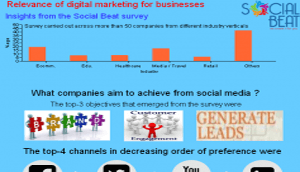Reading Time: 4 minutes
In this digital age, almost all companies want to have a digital strategy but either they do not know how to leverage the digital medium to boost their business or they do not have the required expertise to effectively handle it. After all, digital marketing does not just involve launching a website or creating a facebook page, rather it requires a deeper knowledge of the specific industry in which the company is operating and what channels can leveraged for that particular industry and most importantly, how the online initiatives can be integrated with a company’s overall marketing strategy to boost their businesses significantly.
To get a better understanding of how businesses are leveraging their digital strategy, we carried out a survey amongst 50 companies across industry verticals across the country. The findings were interesting and we have given you summary of it here. You can also download the full Social Beat Digital Marketing Report 2013.
Social Media Marketing
Currently, around 76% of the companies are using social media in one form or the other to leverage their businesses. Moreover, 91% felt that social media has a huge role to play in his/her industry. This shows that there is only a very minuscule percentage who believe that social media does not have a role to play in their industry.
Social media is a great way to build communities around the brand. This is clearly reflected by the survey results where by the respondents felt that brand awareness, customer engagement & generating leads for business seems to be the top-3 objectives of the social media. So, it is definitely a multi-pronged strategy. Initially the focus should be on building the critical mass in terms of number of fans/followers. Now, it is not just about likes and shares for companies, it is also about converting them into tangible benefits for the company, i.e. sales and revenues. But once you have the communities around your brand, you can easily leverage it to your advantage.
Facebook & YouTube seems to be the most preferred channel but Twitter & LinkedIn is also very quickly catching up in India. Facebook and YouTube are visual-driven channels thereby providing great opportunity for B2C companies to target the end-consumers who want visual content.
The quick rise of YouTube as a medium for digital marketing emphasizes the importance of seeing for believing. 2010-2012 period saw the rise of pictures as the prominent medium but the now the focus has changed to videos. Thus, it would not be out-of-place to say that it is evolving from look-n-feel towards a watch-n-feel experience.
Among the B2B companies, LinkedIn and Twitter seems to have a headway. LinkedIn’s relevance among the B2B marketers is not surprising because it is one of the best places to get business leads, create groups based on industry verticals or topics and engage people. Also, getting your employees active on LinkedIn, grow their networks and their active participation in various industry forums can be a great way to impact business relationships through the entire funnel.
Twitter again has attracted the CEOs, top managers & busy professionals. It is a very useful medium for business marketers because of its targeted marketing capabilities using the #-trend feature, break news and announcements, provide link backs. Twitter is a place where all professionals are, this is where real-time conversations happen so it is obvious when you are planning to create buzz in the professional circles, you need to leverage Twitter as a marketing channel.
Marketing Spends & Resources
Around 33% of the companies are ready to spend around Rs. 50000 to Rs. 1 Lakh per month on their social media marketing initiatives. Companies with in-house teams are ready to spend more than 18 hours a week on the internet. Around 50% of the survey respondents are ready to spend more than 18 hours a week on social media marketing.
Now, 18 hours a week is quite a big chunk of time from the marketing initiatives point of view. But there is an associated pitfall here that we can do things but it is important to the right things in a right measure. And this is where the role of digital marketing agencies come to the fore. They know the market and social media dynamics better and can ensure that the investments in terms of money and time do not go down the drain.
Results from Digital Marketing
In our view, unless the digital strategy is leading to tangible results in the medium term then its not worth it. One of our ecommerce client has had a 250% increase in revenues and 300% increase in web traffic since their association with us. This result in the highly competitive ecommerce industry when all players are putting in a lot of effort on the digital marketing is great by any measure. You can read the Ecommerce India Case Study for more information.
Again, one of our healthcare client which is already a leading name in the industry, had a 300% boost in the number of leads generated via digital media. Now, if this result would have been for a new player in the industry, it would have been good but if it is the impact on established businesses, then it clearly says something big. In this case, the returns that were generate due to their social media presence, were far greater than their investments. You can read the Healthcare India Digital Marketing Case Study for more information.
On the whole, the writing on the wall is quite clear. No matter how well-known the business is, if we are ignoring the digital media, we are clearly losing a chunk of our business. How big the chunk is, depends on the industry. But clearly, we would not like to end up on the wrong side. It is all about money. If it is able to drive the revenues for a business, then definitely it is not just a concept. It is for real and here to revolutionize the way marketing is done traditionally.
As goes the famous quote “The biggest ROI for digital marketing, is that your business will still exist after 10 years“










